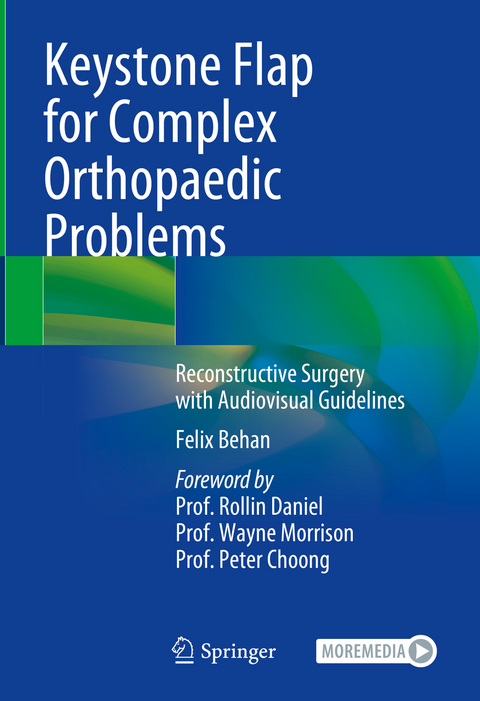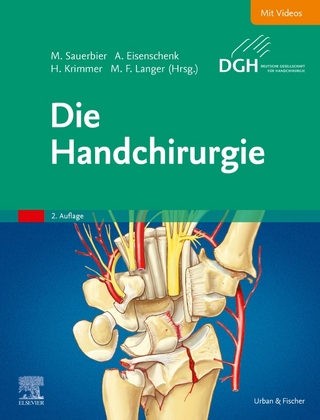
Keystone Flap for Complex Orthopaedic Problems
Springer International Publishing (Verlag)
978-3-031-76701-2 (ISBN)
- Noch nicht erschienen - erscheint am 07.03.2025
- Versandkostenfrei
- Auch auf Rechnung
- Artikel merken
KDPIF, or Keystone Design Perforator Island Flap, is the main reconstructive tool available as a valid alternative to microsurgical procedures; its low complication rate is the key to its surgical success. This stepwise guide illustrates the technique's applications in orthopaedic reconstruction. The sections of the book cover the upper limb (including Dupuytren's disease), the lower limb defects (from groin to foot) and the rare vascular complications of the technique. The illustrations range from simple to complex cases in an easy-to-follow format, with audio files, acting as a supplementary tool to amplify and illustrate the technique to enhance the reader's experience and foster clear understanding. The basic design format for all Keystones are highlighted, all sitting within the dermatomal precincts. The KDPIF must contain a fascial base for lining and must be aligned within the dermatomal precincts. This island outline is an essential pre-requisite for its success. It is hypothesized that this islanding creates a sympathectomy effect resulting in hyperaemic blood flow which optimises healing: the KDPIF technique provides an alternative to microvascular procedures where the biggest drawback is tissue match. The KDPIF addresses this problem admirably with a low pain component, an excellent aesthetic match with a low vascular complication rate and executed in an expeditious manner with sensory recovery and resolution of oedema. Keystone Flap for Complex Orthopaedic Problems: Reconstructive Surgery with Audiovisual Guidelines will be a valued companion to plastic and reconstructive surgeons and orthopaedic surgeons, that might find a valid alternative to microsurgical techniques.
Associate Professor Felix Behan pioneered the reconstructive loco-regional flap called the Keystone Perforator Island Flap. He has a wide experience in Plastic and Reconstructive Surgery, first following his surgical training and clinical attachments in London at the St George's, Royal Marsden and Westminster Hospitals. He has continued in this facility in Head and Neck cancer surgery at the Peter MacCallum Cancer Institute where his appointment in the Head and Neck service extended from 1977 to 2014. He was instrumental in establishing the Melanoma Unit at the Peter MacCallum Cancer Institute, which is now part of the Department of Surgical Oncology. He was formerly Head of Unit in the Plastic & Reconstructive Hand Surgery at the Western Hospital from 1988 where 50% of the work relates to Hand Surgery with cases numbering in the thousands totally per year. He was instrumental in establishing the reconstructive loco-regional flap called the Keystone Perforator Island Flap - KPIF, which has been the main reconstructive tool as an alternative to microsurgical procedures. The first publication of this principle occurred in the ANZ Journal of Surgery in 2003 and its applications since has resulted in over 35 further peer reviewed publications applying the principles all over the body, even in irradiated tissue. He established this clinical record of over 3,500 flaps over 20 years. The characteristics which are so clinically relevant in the Keystone Perforator Island Flap are synopsised by the acronym P.A.C.E.S. - almost Pain free, satisfactory Aesthetic match, Complications of a vascular nature are extremely rare and Economic in terms of theatre time often completed under a 2-hour timeframe compared with the microsurgical alternative and Sensory recovery in usually 3-6 months over the island flap with resolution of oedema, even after a chronic long-term injury. His full-time commitment in surgery in the public service domain, was recognised in the 2024 Australia Day honours list and appointed as a Member of the Order of Australia (AM) for contributions to medicine and surgical teaching.
1. Principles of Keystone Reconstruction.- 2. The Keystone Flap Technique to Reconstruct Palmar Defects Resulting from Dupuytren's Fasciectomy - the Provence of Orthopaedic Hand Surgeons.- 3. The Keystone Flap Technique to Solve Orthopaedic Defects of the Lower Limb from the Inguinal Region to the Dorsum of the Foot.- 4. Potential Complicating Circumstances.
| Erscheint lt. Verlag | 7.3.2025 |
|---|---|
| Vorwort | Rollin Daniel, Wayne Morrison, Peter Choong |
| Zusatzinfo | XIX, 149 p. 466 illus., 458 illus. in color. With online files/update. |
| Verlagsort | Cham |
| Sprache | englisch |
| Maße | 178 x 254 mm |
| Themenwelt | Medizinische Fachgebiete ► Chirurgie ► Ästhetische und Plastische Chirurgie |
| Medizinische Fachgebiete ► Chirurgie ► Unfallchirurgie / Orthopädie | |
| Schlagworte | aestethic reconstruction • Hyperemia • Island pedicle flap • island technique • Keystone Design Perforator Island Flap • loco-regional reconstruction • Low Complication Rate • Oedema • operating timeframe • Perforator Flaps • Reconstructive Surgery |
| ISBN-10 | 3-031-76701-2 / 3031767012 |
| ISBN-13 | 978-3-031-76701-2 / 9783031767012 |
| Zustand | Neuware |
| Informationen gemäß Produktsicherheitsverordnung (GPSR) | |
| Haben Sie eine Frage zum Produkt? |
aus dem Bereich


